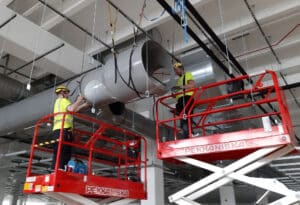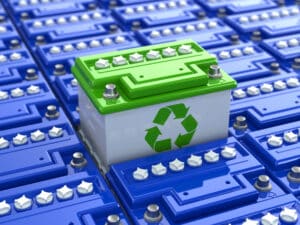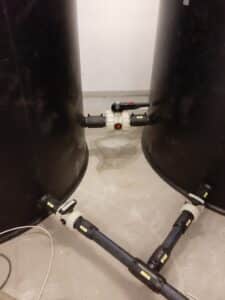The project consisted in replacing a metallic pipeline into two new plastic pipelines. One line should transport caustic soda at 50% concentration and the other sulfuric acid at 90%. Both conduits are used as a transportation between the chemical tanks located outdoors to the laundry process of the factory. Atolli supplied the design, technical advice, materials, installation and maintenance.
MATERIAL SELECTION
The material choice for pipelines must always be based on Operating Pressure and Temperature, Chemical resistance and UV resistance.
- ECTFE
Caustic soda is not safe to use on most of the metals, due to its corrosive properties. Even at higher temperature and with higher concentrations, it does not react with most of plastics and can therefore be applied without problems. However, the use of caustic soda is not recommended for some fluoroplastics, such as PVDF. In this case, PP and PE were not suitable as PP becomes brittle at low temperatures and PE does not comply the life expectancy required by the client. In terms of fittings availability and costs, ECTFE was a better solution than FEP and PFA.
- PVDF
Concentrations of sulfuric acid up to approximately 70% change the properties of PP and PE only slightly. Concentrations higher than 80 % cause oxidation already at room temperature. At higher temperatures, this oxidation can even go to a carbonization of the surface of the PP semifinished products. Meanwhile, PVDF and ECTFE have more resistance to strong acids, and are able to withstand high concentrations. PVDF might suffer from stress cracking if not dimensioned correctly, but it offers a better relation between costs and performance.

MATERIAL SUPPLY
All the pipes, fittings, sheets and some of the valves used in this project were supplied by AGRU, an international company that manufactures and supplies plastic pipeline components and semi-finished products since 1948. AGRU is able to offer a wide range of plastic products for pipeline systems, meaning that, in general, it can cover all the clients demands for a whole project.

INSTALLATION
The installation was run by one of Atolli’s installation teams. The welding method used in this project was IR welding technique, that uses a non-contact heating method to melt and fuse thermoplastic parts together using the energy from infrared radiation. This welding technique helps improving the quality of the welding, as it minimizes the material heated area. This means that the process will be more controlled, and therefore, it will maximize the life time expectancy of the pipe or fitting. Besides, the welding seam is less pronounced than other welding techniques, meaning that the transition between the two parts will be smoother.







